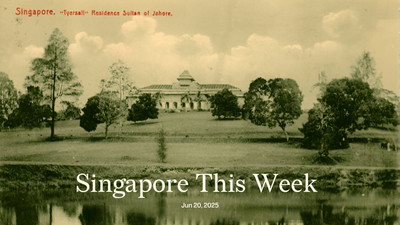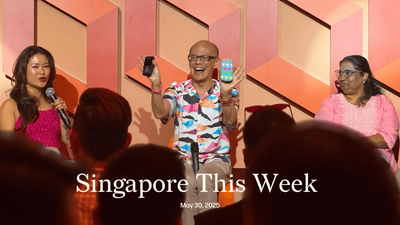Politics: A budget that seems to please many
Handouts to offset the increased goods and services tax (GST). Higher taxes on pricey cars and homes. Amendments to Central Provident Fund contributions that will boost pensions and (presumably) nudge more platform (gig) workers toward financial security. More medical funding for low-income seniors. And greater support for families (though perhaps at the expense of singles, as Rice Media argued). These were some of the highlights of the Budget 2023 presented by Lawrence Wong, deputy prime minister and presumed next leader of the ruling People’s Action Party. Encouragingly, Singapore continues to address the yawning gap in preschool education, which has over the decades led to wildly different starting points in primary school. Wong noted that public spending in the early childhood sector rose from S$320m in 2013 to around S$1.9bn in 2022. Some 88 percent of children aged three to four now attend preschool (a rate still well below the OECD’s leaders). Separately, additional subsidies for buyers of resale HDB flats mean that the government will now offer up to S$190,000 in housing grants for eligible families. The hope is that this provides relief for buyers and tempers the demand in the market for new BTO (build-to-order) flats. The worry, as articulated by Ku Swee Yong in a commentary for CNA, is that the “extra grants are likely to result in resale flat prices going up.” Sellers looking to cash out may capture most of the subsidy, since the resale housing stock is limited (relatively “inelastic supply”, in economic jargon). Some believe this happened in 2020 when some pre-schools upped their fees in response to consumer subsidies. The HDB Resale Price Index has jumped 23 percent in the last two years. This trend may continue—partly fuelled by the government. And since BTO prices are tied to resale ones, won’t they also eventually increase? And is it fair that the government is addressing the housing shortage by subsiding buyers of million-dollar flats? These questions remain unanswered.
Society: Baby steps towards gender equality
The Singaporean fathers of children born from January 1st 2024 will be eligible for four weeks of government-paid paternity leave, double the current two weeks, and subject to employer approval. The government intends to make this scheme mandatory. In announcing it during his Budget speech, Wong said that “the message” behind an extra two weeks leave is to normalise “paternal involvement”. The World Bank found that in the decade till 2021, 37 new countries introduced paid paternity leave, taking the total to 114. Singapore still lags behind countries with longer durations of partially-paid leave, such as Lithuania (30 days of paternity leave and another 36 months of shared parental leave) and Japan (one year of paternity leave). Nevertheless, like in other countries, this scheme should encourage a fairer distribution of household and caregiving responsibilities, of which an “imbalanced division [between] men and women is one of the most resilient features of gender inequality.” A 2021 survey by the National Population and Talent Division showed that the proportion of married respondents who agreed with the statement “Ideally, the mother should take care of her children full-time” fell from 56 percent in 2016 to 40 percent in 2021. By moving away from rigid gender roles, fathers can be more involved in their children’s lives and mothers will be better able to balance motherhood with their careers. (The Survey on Women’s Development found that women in Singapore are nearly four times as likely as men to leave the workforce due to caregiving responsibilities.) It’s less certain if the scheme will boost fertility rates. Noting the “difficult economic and demographic situation” now and in the future, Tan Ern Ser, sociology professor at the National University of Singapore (NUS), said that “couples would be reluctant to bring another child into this world.”
Society: Be still the wrecking ball
If a heritage-worthy building can’t be physically preserved, at least there’ll be an archive of it. The Urban Redevelopment Authority and the National Library Board, with support from the National Heritage Board, are building a living repository to “chronicle Singapore’s modern and contemporary architecture developments”, using materials such as blueprints, models, paraphernalia and photographs. The project will involve a lead architectural historian and a team of six tertiary-level students researching a shortlist of 12 architects over 13 months. Archiving Singapore’s built environment is a significant undertaking long overdue. Some, like Lai Chee Kien, a registered architect and architectural and urban historian, lament that the authorities are “late to the game in many ways with many lacunae to fill.” It’s not lost on the government that place- and memory-making are essential to the moulding of national identity. But technocrats are tough to convince: the decision to finally conserve Golden Mile Complex took many years of pushback from civil society. In reality, the pressures of economic growth and urban renewal (plus the high costs of repurposing the old) often outweigh any desire to conserve what in hindsight would be valuable to the shaping of a young nation. As treasured landmarks have been reduced to rubble—remember Pearl Bank Apartments, the old National Library, National Theatre, and maybe soon People’s Park Complex—cynics might wonder if this archive, though much-needed, could end up being an analgesic balm when other important buildings are eventually demolished.
Internet culture: The best may never be
“In terms of primary education in Singapore, geography is destiny,” Adrian Tan, president of the Law Society, wrote on LinkedIn. Though the government loves to claim that every school is a good one, Tan was simply repeating something many Singaporeans believe. Many fabled schools with storied histories and monied alumni are clustered in Bukit Timah and other rich neighbourhoods, which explains their privileged student bodies. So three bits of news about Anglo-Chinese School (ACS) primary school—from 2030, it will be moving from Barker Road, near some of Singapore’s biggest bungalows, to Tengah, a public housing heartland; it will start accepting girls; and it will be situated next to a special needs school—has caused consternation among many in the elite. “All the ACS parents and alumni thinking ‘oh shit our pure acs going into the hood! Any Beng, Ong and Lim can now enter via 1km route,’” wrote simxbian, an “ah lian” influencer, noting also that “now all the pure breed pedigree gonna mix with Singapore specials like us.” Tjin Lee, a posh influencer, said she was saddened that ACS is “moving out of its historic grounds (with its iconic swimming pool that my grandfather built in his time as principal),” but that she’s proud that it’s “spearheading this move towards inclusiveness.” The internet called out Lee for her apparent humblebragging. “She every time have to mention her whole family study there or affiliated with them,” simxbian wrote. Tan, who grew up in public housing and “was fortunate to win a place at ACS”, said that “in absorbing its values, I became a better man.” He applauded the move. “If I were King of Singapore, I’d decree that every elite school opens a branch in a new public housing estate,” he said. Praising the virtues of a benevolent monarch is, to be sure, another Singapore Special.
Internet culture: Cult(ure) of personality
Online media outfit Our Grandfather Story (OGS) has published a special episode of Tea Talks featuring K Shanmugam, minister for home affairs and law. Previous iterations of Tea Talks have featured conversations with people on the street about mental health, dating, and careers. This is the first episode with a politician. The conversation with Shanmugam included soft topics like his weightlifting regimen and whether he’s ever experienced “imposter syndrome” along with discussions on serious policy like the repeal of 377a and the death penalty. This government is notorious for denying access to journalists who are critical of its record, whether in terms of press conference invitations, comments on stories, or interviews. Perhaps that’s why OGS’s interviewers didn’t push back on incredulous claims from Shanmugam, the architect of laws that have had a chilling effect on speech, that “we should allow free speech” and “people should be allowed to say what they think without the fear of being lynched, virtually.” Jom has previously commented on how tax money is channelled into government advertising, meaning citizens are effectively paying for their own propaganda. But even online content that isn’t sponsored, such as the OGS video, does PR heavy-lifting for the state. Treating politicians as media personalities instead of public figures who ought to be held to account for their decisions may fare well for engagement statistics, but it’s Singaporeans who lose in the long run. (Note: in Jom’s essay this week, we hear from activists who describe how the Protection from Online Falsehoods and Manipulation Act (2019), a Shanmugam-crafted law, has crimped freedom of speech.)
Arts: Singapore’s spoken word scene
Fans of spoken word have much to look forward to in February. First, dink is hosting singer-songwriter Amanda Tee and poet Nicole Shaan for its first event of the year. dink has been a fixture of the scene since 2012, making it Singapore’s longest running open mic. As always, open mic slots are available for any performer who’d like to showcase their work. While dink began as an event for poetry and music, they’ve since expanded their horizons to include any genre that can be performed on a stage. For a different kind of event, audiences can attend (or participate in) Outspoken, a three-round spoken word competitive event for poets. Apart from this month’s competition, Outspoken also has open mic slots available. dink is happening on February 17th at the Sing Lit Station premises on 22 Dickson Road. Tickets are available at the door. Outspoken is on February 23rd at Crane Arab street. Tickets are available via Eventbrite.
History weekly by Faris Joraimi
Singapore’s oldest surviving Hindu temple, Sri Mariamman (built in 1827) was reconsecrated last week following a year-long restoration. Attended by 20,000 devotees, the ritual is called “kumbhabhishekam”, roughly meaning “sprinkling with sacred water from a pot”. Details of the complex and powerful rites can be found here. This is Sri Mariamman’s sixth recorded kumbhabhishekam, held every 12 years since 1936. But Sri Mariamman isn’t Singapore’s first Hindu temple to be built; that honour goes to a Shiva temple called Sri Sivan, on what is today Dhoby Ghaut MRT station. It was a place of worship since 1821, likely used by the Indian sepoys who came with the British East India Company. The nearby Bras Basah River (now Stamford Canal) would have been the natural stream needed to supply the temple with water for ritual activities. A physical structure is recorded to have stood there since the 1850s, while its land grant was awarded in 1868. It was rebuilt at the turn of the 20th century through the patronage of a Tamil woman, Thailammal and her husband V Nagappa Chetty, and donations from other local Hindus. Its Shiva idol, made in Varanasi (formerly Benares), was “believed to be the most beautiful in Malaya.” By the 1950s, modern electric lamps hung beside Sri Sivan’s brass prayer bells. It was neighbours with a Jewish cemetery and the elegant Amber Mansions: one of Singapore’s first examples of modern apartment living (built in 1922). But the Municipal Commissioners wanted Sri Sivan and the Jewish cemetery set back seven feet, to widen Orchard Road. The whole temple had to be rebuilt, and was finished in 1964. Then came the MRT in 1983, and the government decreed that the temple, cemetery and apartments had to go. Some god-forms from that iteration of Sri Sivan were donated to the National Heritage Board, and were recently displayed at a National Gallery exhibition on Singaporean sculpture called “Nothing is Forever”. An apt title, although Sri Sivan lives on today at its present location in Geylang East.
Tech: Geolah, Grab challenger, and its zero-commission strategy
Sick of the surge in Grab prices, especially when you need it the most? Geolah, a Singapore-based mobility start-up offering ride-hailing, food delivery and parcel delivery services, is attempting to shake up the ride-hailing industry by introducing a zero-commission strategy, which will ostensibly benefit both riders and drivers. Co-founder and COO Deniel Singh hopes to attract a large pool of part- and full-time drivers, creating more business opportunities. The company will earn money through rebates from digital payments, insurance, and automotive firms. Geolah also plans to generate income through ads, with a number of brands already on board. This is not too different from Grab’s monetisation plans—advertising revenue is significant at Grab’s Enterprise and New Initiatives arm, as reported in its third quarter 2022 financials. To date, Geolah has recruited around 540 drivers and hopes to have 1,200 by the end of this year, and 30,000 by 2024. Theoretically, a zero-commission strategy should attract consumers seeking lower prices and drivers wanting higher incentives. The success of peer-to-peer marketplaces depends on attaining a critical mass of buyers and sellers. Other zero-commission ride-sharing firms, like Tada, have tried with little success. Grab did this by flinging investor money at drivers in its early days. Yet even Grab, with its commissions, is struggling to find a path to profitability. It’s uncertain if Geolah can truly create a long-term alternative to it.
Tech: Where do the aspirations end?
You might have seen start-up folk using Aspire company cards for payments. Get used to it. Aspire has just raised US$100m (S$132m) in a Series C round led by Sequoia Capital SEA and Lightspeed Venture Partners, two leading venture capital funds. Since it was founded in 2018, Aspire has quickly become a leader in the B2B fintech space in South-east Asia, offering businesses a unified suite of financial services accessible through a single, user-friendly account. The neobank’s low fees and intuitive digital interface have attracted more than 15,000 start-ups and SMBs across the region. It provides them with multi-currency accounts and cards, expense management, payable management and receivable management solutions, recording some US$12bn (S$15.9bn) in annualised total payment volumes in 2022. This gargantuan round of funding is especially impressive given the current downturn in tech funding, further testament to the solid business fundamentals of the company. Other fintechs in the region provide similar offerings. This includes Volopay, Wise and Revolut, which offer business accounts, and Spenmo, which offers business cards. Yet, it’s not just them who’ll be keeping an eye on Aspire—traditional banking incumbents will too.
If you enjoy Jom’s work, do get a paid subscription today to support independent journalism in Singapore.








